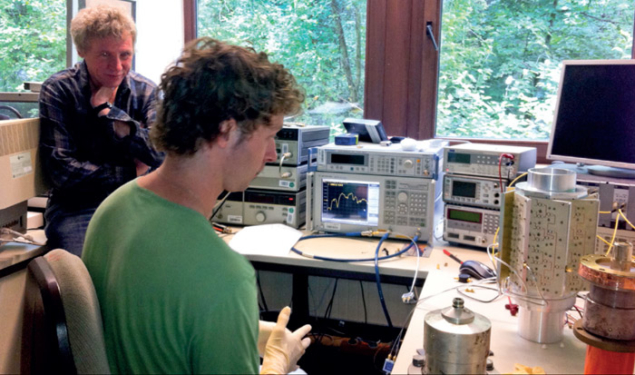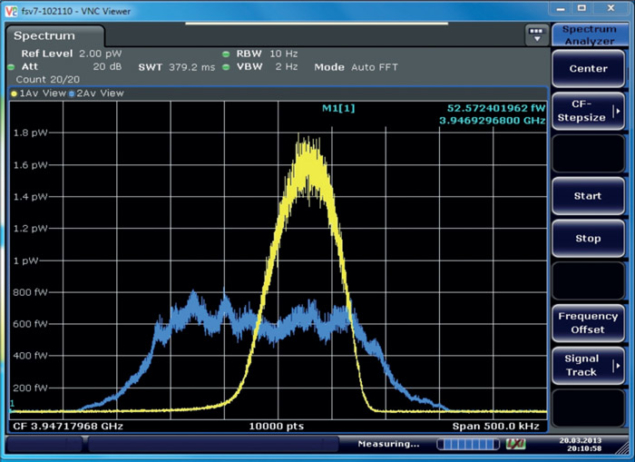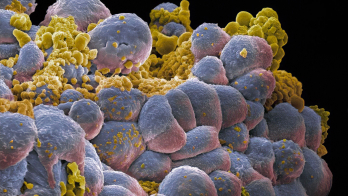Recent runs of JINR’s Nuclotron have tested the stochastic-cooling system being prepared for the future NICA facility.

Image credit: FZJ.
The Nuclotron-based Ion Collider fAcility (NICA) is the future flagship project of the Joint Institute for Nuclear Research in Dubna. In addition to the existing Nuclotron, this accelerator-collider complex will include a new heavy-ion linear accelerator, a superconducting 25 Tm booster synchrotron and two rings for a superconducting collider. The new facility will ultimately provide a range of different ion beams for a variety of experiments with both colliding beam and fixed targets (see box).
Construction of the 3 MeV/u heavy-ion linear accelerator is now under way in co-operation with the BEVATECH Company in Germany; its commissioning in Dubna is scheduled for the end of 2013. Serial production of superconducting magnets for the booster is expected to start in early 2014. The Technical Design Report for the collider complex has meanwhile been approved. As the first step in the realization of the NICA heavy-ion programme, Baryonic Matter at Nuclotron (BM@N) – a new fixed-target experiment developed in co-operation with GSI, Darmstadt – has been approved by JINR’s Programme Advisory Committee and Scientific Council and is now under construction.
In the meantime, the modernized Nuclotron, which will be a key element of the future facility, is being used for basic research in accelerator physics and techniques, the development of modern diagnostics and the testing of prototypes for the collider and booster systems. This is in addition to the implementation of the current physics programme at the superconducting 45 Tm synchrotron. Development work for NICA performed during recent Nuclotron runs include the testing of elements and prototypes for the Multipurpose Detector using extracted deuteron beams; the transportation of the extracted beam (C6+ ions at 3.5 GeV/u and deuterons at 4 GeV/u) to the point where the BM@N detector is under construction; tests of the Nuclotron operating with a long flat-top of the high magnetic field (up to 1000 s, 1.5 T) to simulate the operating conditions of the magnetic system for the collider; and operational tests of the automatic control system based on the TANGO platform, which has been chosen for the NICA facility.
A particularly important step concerned the construction, installation and testing at the Nuclotron of the prototype for the collider’s stochastic cooling system
A particularly important step concerned the construction, installation and testing at the Nuclotron of the prototype for the collider’s stochastic cooling system. This is of major importance for NICA’s heavy-ion programme because beam cooling during collisions is essential for providing maximal luminosity across the whole energy range of 1–4.5 GeV/u. Operational experience of stochastic cooling and experimental investigations of the beam-cooling process at the Nuclotron are therefore a necessity.
The design and construction of the stochastic-cooling channel at the Nuclotron began in mid-2010 in close collaboration with the Forschungszentrum Jülich (FZJ). All stages of the work have been strongly supported by the director of the FZJ’s Institute for Nuclear Physics (IKP), Rudolph Mayer. This R&D is also important to IKP FZJ for testing elements of the stochastic-cooling system designed for the High-Energy Storage Ring (HESR), which will form part of the future international Facility for Antiproton and Ion Research in Darmstadt.
The main task of beam cooling at the HESR will be to accumulate a beam with 1010 antiprotons above 3 GeV at a momentum resolution down to 10–5 for the PANDA experiment. To enhance beam-cooling performance, new ring slot couplers have been developed at FZJ for the pick-up and kicker structures. The pick-ups were tested successfully at the Cooler Synchrotron at FZJ in experiments with the internal target of the Wide-Angle Shower Apparatus.
A pick-up and kicker, each assembled from 16 rings designed for a 2.4 GHz bandwidth, were produced at FZJ for testing at JINR, as the institutes joined forces to prepare for an experiment on stochastic cooling at the Nuclotron. The kicker structure was installed in the room-temperature section of the Nuclotron, with the pick-up structure in the cold section on the opposite side of the 251-m circumference ring, operating at 4.5 K. The first experiments aimed at achieving longitudinal cooling using the filter method. The notch filter and tunable system-delay were implemented on optical lines and a maximum power of 20 W was chosen for the final amplifier.
Construction of the system, its assembly and the cryogenic tests were completed in the autumn of 2011. Then, in December 2011, the equipment was tested for the first time in Nuclotron run 44 with C6+ and deuteron beams. The performance of the system was improved following the results of these first tests, and the software required to adjust the system was developed. This enabled the recent successful test during Nuclotron run 47 in February and March this year, when the system was adjusted to cool the coasting 3 GeV/u deuteron beam and on 20 March the decrease in its momentum spread was demonstrated (figure 1).
To make the effect more observable, the initial momentum spread was increased artificially by manipulation of the RF voltage at the final stage of the beam acceleration. The beam-cooling time of about 360 s is in reasonable agreement with the simulations. Details of this experiment are to be presented at the COOL13 conference in June. Another important result from the recent run was the increase of the maximum deuteron beam energy delivered for physics experiments up to 4.8 GeV/u.

The experimental investigation of stochastic cooling was a complex test of machine performance. During the Nuclotron run, the cryogenic and magnetic systems, power supply and quench-protection systems, cycle control and diagnostic equipment were operated stably in a mode in which the circulation time of the accelerated beam at the flat-top of the magnetic field gradually increased from a few tens of seconds up to eight minutes. The safe operation of the magnetic system was guaranteed by a new quench-detection system commissioned during the run. It permits a prompt change in the number of detectors, combining the work on the group and individual detectors. The detectors for this new method and their automatic control systems were developed at the Nuclotron and have been chosen for manufacture and installation on the NICA booster. The system provides monitoring of the statuses of all of its components, as well as signal testing of external systems, and also indicates malfunctions.
These tests were the result of an international team effort: A Sidorin, N Shurkhno, G Trubnikov (JINR, Dubna) and R Stassen (IKP FZJ) supervised all stages of the system design and participated in the Nuclotron shifts dedicated to testing and adjusting the equipment; T Katayama and H Stockhorst (GSI and IKP FZJ) performed simulations of the cooling-process dynamics and experimental measurements; L Thorndahl and F Caspers (CERN) contributed to the design and simulation of RF structures.
NICA's Objectives
The NICA facility will provide experiments with:
• extracted ion beams (from protons up to gold or uranium nuclei) at kinetic energies up to 13.8 GeV (for protons), 6 GeV/u (for deuterons) and 4.5 GeV/u for heavy nuclei. The fixed-target experimental BM@N is under construction by a JINR-GSI collaboration;
• colliding heavy-ion beams with a kinetic energy in the range 1–4.5 GeV/u at a luminosity of 1027 cm–2 s–1;
• colliding heavy and light ions with the same energy range and luminosity;
• colliding polarized beams of light ions in the kinetic energy range 5–12.5 GeV/u for protons and 2 – 5.8 GeV/u for deuterons, at a luminosity level not less than 1031 cm–2 s–1.
NICA’s beams will be available to these experimental areas and facilities:
• 10,000 m2 experimental hall for fixed-target experiments, using slow, extracted beams from the Nuclotron;
• the dedicated experimental hall for applied research on extracted ion beams from the booster;
• the collider of heavy and light polarized ions, equipped with the MultiPurpose Detector and the Spin Physics Detector for fundamental research;
• an internal target station in the Nuclotron cryomagnetic system for research, including relativistic atomic physics and spin physics.








